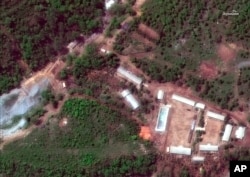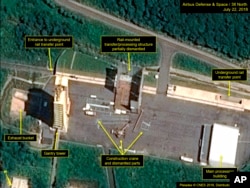U.S. Secretary of State Mike Pompeo is calling his recent trip to Pyongyang a success, but experts experienced in negotiating with Pyongyang remain unclear what he achieved in his meeting with North Korean leader Kim Jong Un.
Pompeo made his fourth trip to Pyongyang on Sunday and met with Kim to discuss steps North Korea is willing to take toward denuclearization and to prepare for the second summit between President Donald Trump and Kim.
Arriving in Seoul on Monday after his meeting in Pyongyang, Pompeo said "significant progress" was made in his talks with Kim and that they were "pretty close" to agreeing on the details of the second summit.
Pompeo also said Kim agreed to open North Korea's Punggye-ri nuclear test site and Sohae missile engine site to international inspectors.
Significant progress doubted
Evans Revere, a former State Department official who negotiated with North Korea and is now a nonresident senior fellow at the Brookings Institution, a U.S. research group, said, "I've looked hard for any signs that significant progress was made on denuclearization, but have found none."
Ken Gause, director of the International Affairs Group at the Center for Naval Analyses, a research and development center serving the Navy and other U.S. defense agencies, also doubted that any meaningful steps were taken during Pompeo's latest meeting with Kim.
"I was kind of surprised that he said that there has been significant progress because nobody seems to have any information that suggests something significant took place," said Gause.
Revere said North Korea managed to use its test sites as a "trading bait" to gain concessions from the U.S.
"On the nuclear weapons front, it seems clear that the North Koreans are eager to get as much mileage out of their promise to shut down and dismantle the two facilities at Punggye-ri and Sohae as possible," said Revere. "It will be interesting to see what the U.S. is asked to give up in order to gain access."
Sohae site destroyed?
The Sohae missile test site, also known as Tongchang-ri, was the facility that Kim had pledged to take down in front of international inspectors when he met with South Korean President Moon Jae-in at their third inter-Korean summit held in September.
The Punggye-ri site consists of underground tunnels where North Korea conducted all of its nuclear tests. In May, North Korea blew up the tunnels to show its commitment toward denuclearization as foreign journalists observed the destruction.
Christopher Hill, a chief negotiator with North Korea during the George W. Bush administration, said Kim needs to propose something more meaningful than dismantling the Punggye-ri site.
"We all agreed or understood that Punggye-ri was nearing the end of its shelf life," said Hill. "I would like to see some progress in terms of their acknowledging what they have and discuss plans for shutting those things down, rather than just choosing things on their own."
Gary Samore, the White House coordinator for arms control and weapons of mass destruction during the Barack Obama administration, however, believes Washington and Pyongyang moving toward the second summit indicates that "progress was made" at the Pompeo's meeting with Kim.
Inspections would be 'major breakthrough'
David Albright, a former U.N. nuclear inspector and current nuclear proliferation analyst at the Institute for Science and International Security, a Washington NGO that informs the public about science and policy issues affecting global security, said allowing inspectors at the North Korea's key nuclear testing site could be "a major breakthrough" that might reveal crucial clues to what types of nuclear weapons North Korea possesses and how many there are.
"The United States would love to be able to do testing and sampling at the test site where it would be able to tell whether the weapons were plutonium or weapons-grade uranium or both," said Albright.
Albright said if the North Koreans are testing plutonium, they probably have no more than a dozen nuclear weapons in their possession. But if they are testing weapons-grade uranium, the number of nuclear weapons they have might range from 20 to 60. The big variance on the assessment, according to Albright, results from not knowing if they are using weapons-grade uranium and how much they have used.
"The goal from [the inspectors'] point of view would be to sample the radioactive debris left over from the tests and then, secondarily, to know that the test tunnels are totally destroyed as advertised by the North Koreans," said Albright.
More talks set
Stephen Biegun, the U.S. special representative for North Korea who accompanied Pompeo to Pyongyang, is slated to meet with North Korean Vice Foreign Minister Choe Son Hui soon to further discuss North Korea's denuclearization and Trump's summit with Kim.
On Tuesday, Trump said his second summit with Kim would be held after the U.S. midterm elections in November.
Ham Ji-ha and Ahn So-young contributed to this report, which originated with VOA's Korean service.










